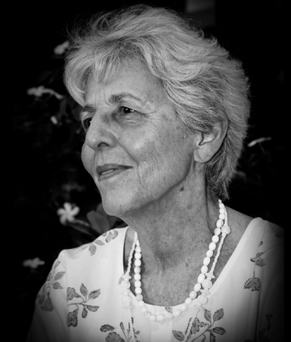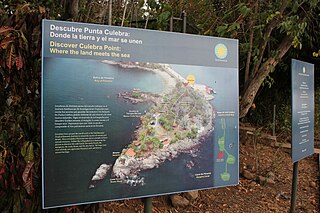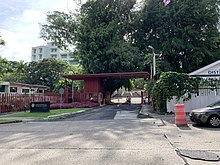
Barro Colorado Island is located in the man-made Gatun Lake in the middle of the Panama Canal. The island was formed when the waters of the Chagres River were dammed to form the lake in 1913. When the waters rose, they covered a significant part of the existing tropical forest, but certain hilltops remained as islands in the middle of the lake. It has an area of 15.6 km2 (6.0 sq mi).
Alexander Graham Bell Fairchild was an American entomologist, and a member of the Fairchild family, descendants of Thomas Fairchild of Stratford, Connecticut and one of two grandsons of the scientist and inventor, Alexander Graham Bell, for whom he was named, and son of David Fairchild, a botanist and plant explorer.
Stephen P. Hubbell is an American ecologist on the faculty of the University of California, Los Angeles. He is author of the unified neutral theory of biodiversity and biogeography (UNTB), which seeks to explain the diversity and relative abundance of species in ecological communities not by niche differences but by stochastic processes among ecologically equivalent species. Hubbell is also a senior staff scientist at the Smithsonian Tropical Research Institute in Balboa, Panama. He is also well known for tropical forest studies. In 1980, he and Robin B. Foster of the Field Museum in Chicago, launched the first of the 50 hectare forest dynamics studies on Barro Colorado Island in Panama. This plot became the flagship of a global network of large permanent forest dynamics plots, all following identical measurement protocols. This global network now has more than 70 plots in 28 countries, and these plots contain more than 12000 tree species and 7 million individual trees that are tagged, mapped, and monitored long-term for growth, survival and recruitment. The Center for Tropical Forest Science coordinates research across global network of plots through the Smithsonian Tropical Research Institute. The program has expanded into the temperate zone, and is now known as the Forest Global Earth Observatory Network or ForestGEO.

Martin Humphrey Moynihan was a behavioral evolutionary biologist and ornithologist who studied under Ernst Mayr and Niko Tinbergen, and was a contemporary of Desmond Morris. He was the founding director of the Smithsonian Tropical Research Institute (STRI) in Panama.

Pedasí is one of five districts of the Los Santos Province, Panama.
The Organization for Tropical Studies (OTS)/Organización para Estudios Tropicales (OET), founded in 1963, is a non-profit consortium of over 50 universities and research institutions based in the United States, Latin America, and South Africa. OTS manages a network of ecological research stations in Costa Rica and South Africa. The North American Office is located on the Duke University campus in Durham, North Carolina. OTS offers a variety of courses in Spanish and English for high school, university, graduate students and professionals. Most of the coursework and research conducted at OTS stations focuses on tropical ecology, and the three research stations in Costa Rica are located in distinct ecoregions. OTS provides housing and a cafeteria for students researchers, and sometime ecotourists. OTS is involved in the policy related to tropical biology through courses, hosting meetings and conferences and managing conservation related projects

Elisabeth Klara Viktoria Kalko was a German tropical scientist and ecologist working at the Smithsonian Institution and the University of Ulm.

The Liquid Jungle Lab (LJL) is a tropical marine research station on the island of Canales de Tierra on the western coast of Pacific Panamá along a primary marine biological corridor. The LJL research campus was completed in 2004 and is part of a private 3,500 hectare reserve composed of primary forest, mangroves, tide pools, and a rocky inter-tidal zone that transitions into fringing coral reefs.
The Bocas del Toro Research Station (BRS) is a field station of the Smithsonian Tropical Research Institute (STRI) on Panama’s western Caribbean coast, is a platform for both marine and terrestrial biodiversity research. The station hosts a diverse group of scientists from more than 20 countries, every year.

Olga Francesca Linares was a Panamanian–American academic anthropologist and archaeologist, and senior staff scientist (emerita) at the Smithsonian Tropical Research Institute (STRI) in Panama, who supported much of her research throughout her career. She is well known for her work on the cultural ecology of Panama, and more recently in the Casamance region of Southern Senegal. She is also concerned with the social organization of agrarian systems as well as the relationship between "ecology, political economy, migration and the changing dynamics of food production among rural peoples living in tropical regions".

Tachigali versicolor or the suicide tree is a species of tree found from Costa Rica to western Colombia. It is monocarpic, flowering only once before dying, which gives rise to its common name of the "suicide tree".

Platypodium elegans, the graceful platypodium, is a large leguminous tree found in the Neotropics that forms part of the forest canopy. It was first described by Julius Rudolph Theodor Vogel in 1837 and is the type species of the genus. The tree has been known to grow up to 30 metres in height and have a trunk with a diameter up to 1 m at breast height. Its trunk has large holes in it, sometimes making it possible to see through the trunk. The holes provide a habitat for giant damselflies and other insects both when alive and once the tree has died and fallen over. It has compound leaves each of which is made up of 10–20 leaflets. Three new chemical compounds have been isolated from the leaves and they form part of the diet of several monkeys and the squirrel Sciurus ingrami. In Panama it flowers from April to June, the flowers contain only four ovules, but normally only one of these reaches maturity forming a winged seed pod around 10 cm long and weighing 2 g. During the dry season around a year after the flowers are fertilised, the seeds are dispersed by the wind and the tree loses it leaves. The seeds are eaten by agoutis and by bruchid beetle larvae. The majority of seedlings are killed by damping off fungi in the first few months of growth, with seedlings that grow nearer the parent trees being more likely to die. The seedlings are relatively unable to survive in deep shade compared to other species in the same habitat. Various epiphytes are known to grow on P. elegans with the cactus Epiphyllum phyllanthus being the most abundant in Panama. Despite having holes in its trunk which should encourage debris and seeds to collect, hemiepiphytes are relatively uncommon, meaning that animals are not attracted to it to feed and then defecate. It has no known uses in traditional medicine and although it can be used for timber, the wood is of poor quality.

The Punta Culebra Nature Center is a visitor center located in Panama City, on one of the islands connected by the Amador Causeway. It is operated by the Smithsonian Tropical Research Institute, also located in Panamá. The center focuses mainly on marine and terrestrial science and education, conservation and interpretation of marine coastal environments in the tropics. Among its attractions, the Fabulous Frogs of Panama, a touch tank with equinoderms and turtles are some of the exhibits found in Punta Culebra. A trail to a stretch of tropical dry forest is also part of the attractions where free roaming animals such as raccoons, sloths, green iguanas and beautiful birds and butterflies can be found.

Ira Rubinoff is an American marine biologist and was a former director of the Smithsonian Tropical Research Institute in Panama.
James Zetek (1886–1959) was an American entomologist and authority on the natural history of Panama.
Egbert Giles Leigh, Jr. is an evolutionary ecologist who spends much of his time studying tropical ecosystems. He is a researcher for the Smithsonian Tropical Research Institute and is well known for the work he has done on Barro Colorado Island. He is a US citizen, but has resided at the Smithsonian in Panama for nearly 50 years. Along with studies on Barro Colorado Island, Leigh is also known for the research he has done related to the Isthmus of Panama and its historical significance on the evolution of South American species.
Annette A. Aiello is an American zoologist, botanical entomologist, and professor. She develops academic activities at the Smithsonian Tropical Research Institute.

Sericopelma embrithes is a tarantula that is native to Panama. To date, only specimens from Barro Colorado Island have been studied. Like other tarantulas, it is relatively large compared to other spiders. It can grow up to 59 mm long, including its chelicerae. S. embrithes is data deficient according to the IUCN.
Henk Wolda is a Dutch entomologist. He was an employee at the Smithsonian Tropical Research Institute (STRI) in Panama, where he studied insects. During the 1980s he was one of the top publishers on biodiversity based in Panama. His papers from circa 1974 to 1990 are kept in the Smithsonian Institution Archives. His insection collection is held at the STRI, and derived from performing light trapping techniques, with large numbers coming from Barro Colorado Island.












